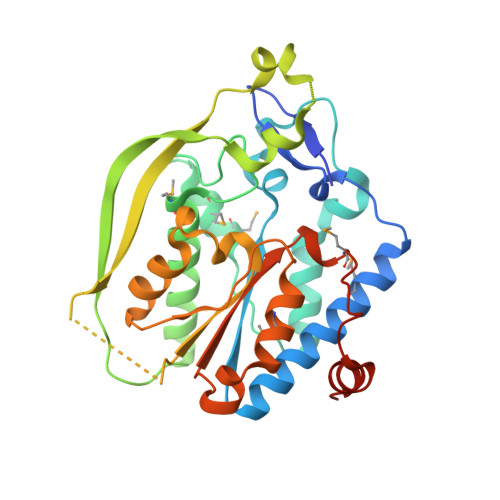P. aeruginosa SGNH Hydrolase-Like Proteins AlgJ and AlgX Have Similar Topology but Separate and Distinct Roles in Alginate Acetylation.
Baker, P., Ricer, T., Moynihan, P.J., Kitova, E.N., Walvoort, M.T., Little, D.J., Whitney, J.C., Dawson, K., Weadge, J.T., Robinson, H., Ohman, D.E., Codee, J.D., Klassen, J.S., Clarke, A.J., Howell, P.L.(2014) PLoS Pathog 10: e1004334-e1004334
- PubMed: 25165982
- DOI: https://doi.org/10.1371/journal.ppat.1004334
- Primary Citation of Related Structures:
4O8V - PubMed Abstract:
The O-acetylation of polysaccharides is a common modification used by pathogenic organisms to protect against external forces. Pseudomonas aeruginosa secretes the anionic, O-acetylated exopolysaccharide alginate during chronic infection in the lungs of cystic fibrosis patients to form the major constituent of a protective biofilm matrix. Four proteins have been implicated in the O-acetylation of alginate, AlgIJF and AlgX. To probe the biological function of AlgJ, we determined its structure to 1.83 Å resolution. AlgJ is a SGNH hydrolase-like protein, which while structurally similar to the N-terminal domain of AlgX exhibits a distinctly different electrostatic surface potential. Consistent with other SGNH hydrolases, we identified a conserved catalytic triad composed of D190, H192 and S288 and demonstrated that AlgJ exhibits acetylesterase activity in vitro. Residues in the AlgJ signature motifs were found to form an extensive network of interactions that are critical for O-acetylation of alginate in vivo. Using two different electrospray ionization mass spectrometry (ESI-MS) assays we compared the abilities of AlgJ and AlgX to bind and acetylate alginate. Binding studies using defined length polymannuronic acid revealed that AlgJ exhibits either weak or no detectable polymer binding while AlgX binds polymannuronic acid specifically in a length-dependent manner. Additionally, AlgX was capable of utilizing the surrogate acetyl-donor 4-nitrophenyl acetate to catalyze the O-acetylation of polymannuronic acid. Our results, combined with previously published in vivo data, suggest that the annotated O-acetyltransferases AlgJ and AlgX have separate and distinct roles in O-acetylation. Our refined model for alginate acetylation places AlgX as the terminal acetlytransferase and provides a rationale for the variability in the number of proteins required for polysaccharide O-acetylation.
- Program in Molecular Structure and Function, Research Institute, The Hospital for Sick Children, Toronto, Ontario, Canada.
Organizational Affiliation:

















